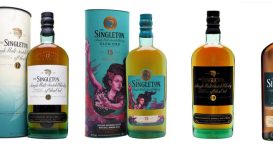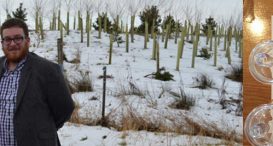Does age really matter in whisky? Some more thoughts on the age-less bottle debate…
let’s begin
Every whisky writer, blogger, producer, drinker, consultant, marketeer and sales person has an opinion on whether whisky is better with or without an age statement on the bottle.
Now, last year I wrote about this and asked various questions around the subject and explained that my viewpoint is that by removing the shackles of having to design and formulate whisky to certain age statements, you actually unleash the creativity of a Master Blender or Master Distiller to create great liquids that could be a mix of young and old.
I wrote about this a couple of years ago here, if you’re interested.
But why do people get so hung up on age statements?What is it about whisky that means older Whiskies are better and younger ones are worse?Why is there such disdain in the whisky blogging community when a new limited edition NAS is released and priced above £50?
For me it is a bit of a shame that whisky producers are instantly given a load of grief when a bottle such as Laphroaig’s Lore at £75 or Ardbeg’s Dark Cove at £96 are released, to a chorus of ‘… Not another overpriced NAS…’ and ‘… It’s alright for the price, one of the better NAS releases this year…’.
Surely it should not be about the NAS-ness is the main response to a new release?
Recently I was fortunate enough to speak at length with Richard Pattersen on the subject whilst at The Dalmore distillery, and he made a superb point:
“None of my counterparts would ever release anything unless it was up to a very high standard, it just won’t happen, their reputation is always on the line. It takes time to bring whisky together in loving union but age is not the most important thing”
On a recent vineyard visit I started thinking about the NAS debate and how in wine it is perfectly acceptable to blend young and old to create interesting expressions without compromising on quality and without being labelled ‘alright… for an NAS wine’.
When speaking with a winemaker in Carcassone, southern France, he explained that young vines and old vines create a healthy mix of flavours, leading to a solid product.
Specifically, the younger vines gave him more spritely, uninhibited flavour profiles, where the old were used for fruitier notes in the end product, and that was the established way of doing things; to blend wines together to create perfect favours.
Another analogy we could use here is that both winemakers and Master Blenders / Distillers are like painters – the person has all the colours on their board to mix together and create different hues and colour depths and whatnot then choose the best ones to create a perfect picture.
Mixing, matching, choosing high notes, low notes, but all with the vision in their mind about what they want the end image to be, showcasing the dexterity of their talent and, in whisky’s case, the distillery’s character; not creating something that meets the requirements to stamp a number on it.
When speaking with Richard Paterson on this subject, he passionately answered my question thus:
“All my counterparts would never release anything unless it was up to a very high standard, it just won’t happen, their reputation is always on the line. It takes time to bring whisky together in loving union but age is not the most important thing.”
For example; The Dalmore’s 25 Year Old single malt, a divine whisky, has only 1% 25 Year Old whisky in there, the rest is made up of much more aged liquids. You don’t get to know the full composition unless you ask a few questions and have access to certain people but it is interesting once you know that the age is clearly important for this release as it is one of their marquee expressions but that the number is effectively second vs. the liquid quality itself.
This debate will roll on, and several brand teams I’ve spoken to don’t understand the negativity.
Interestingly, new-to-market whisky consumers will be decreasingly reliant on age statements on bottles to navigate the whisky category.
What are your thoughts on the debate?
Here are some of your questions on the subject answered…
Is the Scottish Whisky industry running out of real Whisky?
It’s common sense; waiting for every malt’s coming of age party before it can be bottled puts limitations on proceedings. There are only so many times 21 years come to pass, usually once every couple of decades or so.
It’s not really that we’re running out, more that we have to be willing to be patient, because no one could have predicted this level of demand 20 years ago. But yes, there is a lack of mature stock, and that has prompted the NAS trend.
Of course there are some cases, such as the Rosebank Distillery in the Scottish Lowlands, where production has closed down and we’re feasting on the last of the nectar as it comes to maturation. But there are also new distilleries hoping to begin production, such as Shetland’s Blackwood Distillery in Scotland.
Why did they start producing NAS?
In addition to the lack of mature stock and closing distilleries, NAS has arguably come to pass in an attempt to make Whisky production more creative and shift the ‘focus’ from age to other aspects.
However, there are financial motives, because this is planet Earth. Every year that stock matures, 2% of the liquid a year evaporates, known as the angel’s share. Sharing with the angels is expensive, and the younger the Whisky, the more we can ensure the angel’s don’t take their milkshake from our yard.
"How do you spot an NAS?
If you don’t spot an age on the label, you’ve spotted an NAS Whisky. Hey presto, if only bringing yourself to drink one and escaping the stigma was that easy.
The spirits are usually given a clever, distracting name in place of their age. Classic offenders include things such as ‘Traditional Cask’ (it’s age-old tradition, the same, nothing to see here), ‘Four Wood’ (who cares about years when you can count trees?) or something flash and Gaelic like ‘Cairdeas’ (which could, in some fictitious realms, mean ‘really old’).
In NAS’ defence, their names generally denote their focus. So once you’re over the fact that you’re having an affair with a spring chicken, which generally people manage to do in life, you can enjoy finding out about this malt’s alternative forte.













6 thoughts on “Does age really matter in whisky? Some more thoughts on the age-less bottle debate…”
Well-written piece, but it ignores the biggest problem I have with NAS: the price. Younger whiskies are less expensive to produce than older ones. This is not my opinion, it’s an objective economic fact. When a distillery drops the age statement and replaces a substantial quantity of older spirit with younger spirit, the price should go down. But this doesn’t happen. I’m all for “freedom of expression” but it should go hand in hand with ethical pricing and “freedom of information”. While some distillers will disclose everything a customer could hope to know about a particular expression (and should be lauded for doing so) most answer with obscurantist marketing-speak: e.g. “Carefully selected whiskies AS OLD AS x years old”
Tell me the age of the whiskies in a NAS as well as the percentage of the total each represents, and I’ll make my informed decision. So long as distillers insist on secrecy, I’m not buying any NAS whisky.
Totally see your point, but the wood is also a factor, not just age… and the brilliance of weaving of flavour profiles together. Your point comes down more to the transparency and the composition of blends and single malts. We are getting there, lots of brands are starting to speak more openly about their recipes. But should age be the only things we buy on? That’s the main point… I don’t believe so, I have tried many very aged whiskies I’ve not been enamoured by, but say a 5 year old Laphroaig I tried last week – that was stunning. So it comes down to balance… and if the number is all that’s required to show a whisky is fantastic, then so be it, but personally I think there is so much more.
Again, I have no problem with the concept of NAS. I have a problem with secrecy and marketing hype to drive higher prices while selling, objectively speaking, whiskies that cost less to produce. And yes, that includes the potential cost of different casks. I wrote about the pricing issue on my blog (and included links in said article). A whisky that spends 18 or more years in the cask costs more to produce than one that has spent 5 years in the cask, because of costs associated with warehousing, liquid lost to angels’ share etc. All of this has nothing to do with taste whatsoever. A 5 year old may be “better” to some than an 18 year old. And that’s fine. But replacing an age guaranteed malt which contains mostly 15 year old spirit with an NAS that contains mostly <10 Year Old spirit should NOT result in a price increase. Here's a link to my blog in case you're interested. Sláinte!
http://ontarioscotchlover.blogspot.ca/2017/05/you-cant-handle-truth-nas-scotch-is.html?m=1
All too often, novices equate age with quality. I’ll also point out these are some of the same folks that think all blends are inferior to any single malt. So I take these comments with a grain of salt.
Older whisky has some intrinsic value to it, but lets be honest, the actual cost of letting a whisky sit for 10 or 20 years really can’t be much. It certainly doesn’t warrant doubling the price or more for every ten years. On the flip side, just because a whisky is younger doesn’t mean it should be cheap.
The answer to all of this, in my opinion of course, is to allow producers to disclose exactly what they use to create their bottled product. Look at John Glaser’s Three Year Old Deluxe… Less than 1% of the spirit is actually three years old and the rest is made up of spirits that are up to 20 years old, from what I hear. But because of the insane laws of scotch, they can only report the three year old component. If producers were able to give complete transparency, the way John wants to, it would eliminate the craze of NAS releases.
Compass Box and Bruichladdich disclose the complete components of their whiskies on their websites, which is a step in the right direction. I’m not saying older=better but the go-to defence of NAS whisky always seems to be “but I like Uigeadail/Macallan Sienna/Laphroaig Lore/Whatever”. Personal preferences do not change physical facts. Age affects whisky (for better or worse). Removing the age information and saying it doesn’t matter all of a sudden is ludicrous. If you remove the speedometer from your car, do you think you can convince a police officer that “speed doesn’t matter”? Of course not. I have no problem with multivintaging, but I refuse to buy NAS until the marketing shenanigans cease.